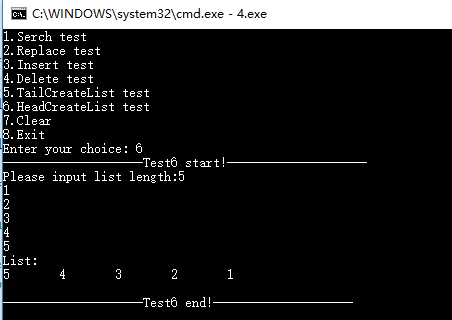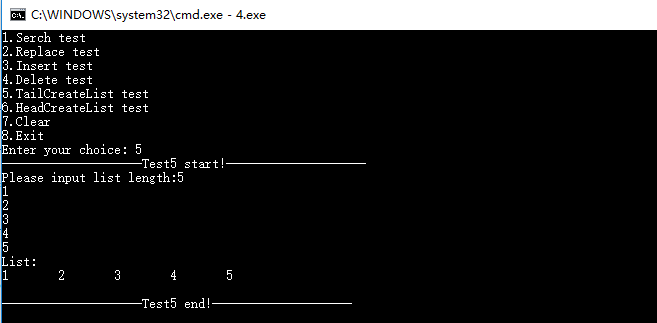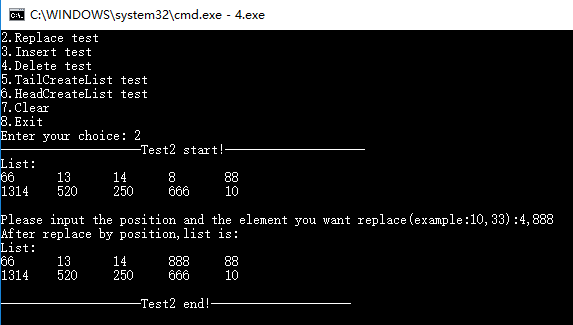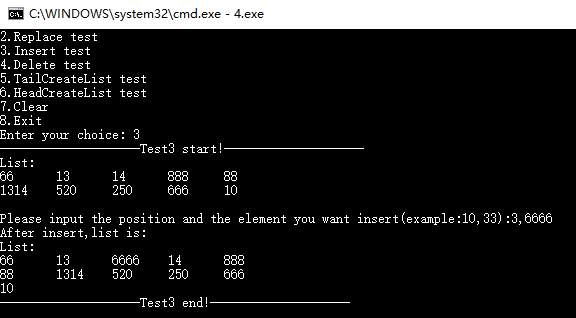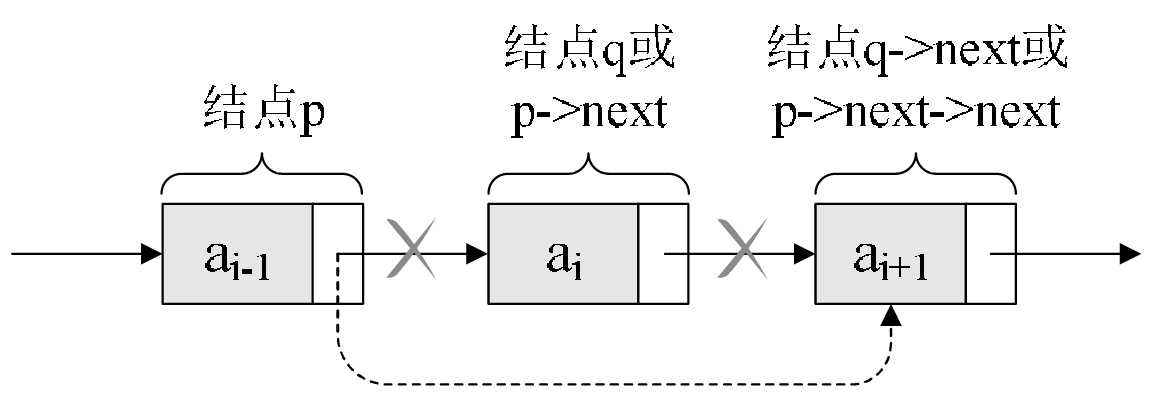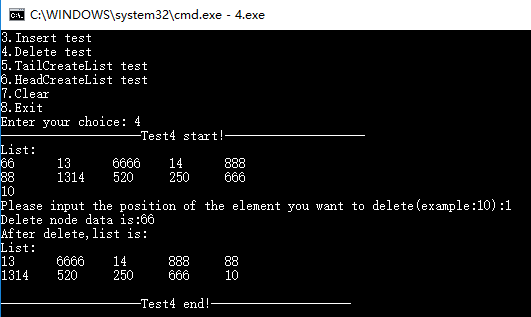- 1微信小程序开发之——获取系统信息(1)_微信小程序获取运行系统信息
- 2C++ 动态规划_c++动态规划
- 3使用 Ollama框架 下载和使用 Llama3 AI大模型的完整指南_利用ollama进行大模型的更新
- 4太厉害了!终于有人把Hadoop+Spark,典型服务器模式原理分析与实践_spark和hadoop集成案例
- 5十进制计数器和BCD七段译码数码管显示的VHDL实现_七段数码管十进制显示器
- 6计算机野史-图灵
- 7Redis过期策略以及内存淘汰机制_redis的过期策略以及内存淘汰机制
- 8kernelbasedll故障修复问题,怎么一键解决kernelbasedll
- 92024年Go最新NLP 实战 (7) 热榜算法更新(1),2024年最新整理了3家面试问题:美团+字节+腾讯
- 10理解IP ACL
数据结构与算法 | 单链表的基本操作_6-1 单链表结点和
赞
踩
1024G 嵌入式资源大放送!包括但不限于C/C++、单片机、Linux等。关注微信公众号【嵌入式大杂烩】,回复1024,即可免费获取!
线性表的存储结构有顺序存储结构(顺序表)和链式存储结构(链表)两种。顺序表在之前的博客有介绍过,不明白的朋友可查看:静态分配顺序表的基本操作及动态分配顺序表的基本操作。相对于顺序表来说,链表稍微难一些,本人花了两天的时间认真查看了一些资料,终于大致明白了一些东西。现在做一些总结,分享给大家,有错误的地方欢迎大家指正。
一、相关概念术语
1、链表结点由数据域(存放本身信息)和指针域(指向后继结点的指针)构成。如下图所示:
图1 结点的构成
其C语言定义可表示为:
- typedef struct LNode
- {
- int data; //data中存放结点数据域(默认是int型)
- struct LNode *next; //指向后继结点的指针
- }LNode;
2、头结点:在开始结点之前的结点(可有可无)。其值域不包含任何信息。
3、开始结点:第一个元素所在的结点。
4、头指针:永远指向链表中第一个结点的位置(如果链表有头结点,头指针指向头结点;否则,头指针指向开始结点)。
5、单链表
图2 带头结点的单链表
(1)带头结点的单链表:头指针head指向头结点。头指针head始终不等于NULL,head->next等于NULL的时候链表为空。
(2)不带头结点的单链表:头结点head指向开始结点,即图2中的a1,当head等于NULL时链表为空。
6、头结点和头指针的区别:头指针是一个指针,头指针指向链表的第一个结点(如果链表有头结点,头指针指向头结点;否则,
头指针指向开始结点);头结点是一个实际存在的点,它包含有数据域和指针域。两者在程序上的直接体现就是:头指针至声明
而没有分配存储空间,头结点进行了声明并分配了一个结点的实际物理内存。
二、代码部分
1、单链表结点定义
- typedef struct LNode
- {
- int data; //data中存放结点数据域(默认是int型)
- struct LNode *next; //指向后继结点的指针
- }LNode;
2、单链表的创建
单链表的创建有两种方法,即头插法和尾插法。原理如下图所示:
图3 头插法与尾插法
(1)头插法创建单链表(生成的链表是逆序的)的代码如下:
- LNode *HeadCreateList(int len)
- {
- LNode *L = (LNode*)malloc(sizeof(LNode)); //创建一个头结点
- LNode *temp = L;//声明一个中间变量,指向头结点,用于遍历链表(曾因没有这个中间变量而出错)
- temp->next = NULL; //该链表此刻只带头结点
-
- for(int i=1;i<=len;i++) //循环申请len个结点来接收scanf得到的元素
- {
- LNode *p = (LNode*)malloc(sizeof(LNode)); //生成新结点
- scanf("%d",&p->data); //用新申请的结点来接收scanf得到的元素
- /* 以下两条语句是头插法的关键步骤,与本工程"Insert"函数原理一样 */
- p->next = temp->next; //新结点的next指针指向开始结点
- temp->next = p; //头结点的next指针指向新结点
- }
-
- return (LNode*)L;
- }

程序运行结果如下:
(2)尾插法创建单链表(生成的链表是顺序的)的代码如下:
- LNode *TailCreateList(int len)
- {
- LNode *L = (LNode*)malloc(sizeof(LNode)); //创建一个头结点
- LNode *temp = L;//声明一个中间变量,指向头结点,用于遍历链表(曾因没有这个中间变量而出错)
- temp->next = NULL;//该链表此刻只带头结点
-
- for(int i=1;i<=len;i++) //循环申请len个结点来接收scanf得到的元素
- {
- LNode *p = (LNode*)malloc(sizeof(LNode)); //生成新结点
- scanf("%d",&p->data); //用新申请的结点来接收scanf得到的元素
- /* 以下两条语句是尾插法的关键步骤 */
- temp->next = p; //用来接纳新结点
- temp = p; //指向终端结点,以便于接纳下一个到来的结点,此语句也可以改为"L = L->next"
- }
- temp->next = NULL; //此刻所有元素已经全装入链表L中,L的终端结点的指针域置为NULL
-
- return (LNode*)L;
- }

程序运行结果如下:
2、链表中查找某结点
因为链表不支持随机访问,即链表的存取方式是顺序存取的(注意“存储”与“存取”是两个不一样的概念),所以要查找某结点,必须通过遍历的方式查找。例如:如果想查找第5个结点,必须先遍历走过第1~4个结点,才能得到第5个结点。代码如下:
- int Serch(LNode *L, int elem)
- {
- LNode *temp = L;
- int pos = 0;
- int i = 1;
-
- while(temp->next)
- {
- temp = temp->next;
- if(elem==temp->data)
- {
- pos = i;
- printf("The %d position in the list is %d\n",elem,pos);
- return pos; //返回elem元素在顺序表中的位置
- }
- i++;
- }
- printf("Serch error!\n");
-
- return ERROR; //查找失败
- }

程序运行结果如下:
3、修改某结点的数据域
要修改某结点的数据域,首先通过遍历的方法找到该结点,然后直接修改该结点的数据域的值。代码如下:
- LNode *Replace(LNode *L, int pos, int elem)
- {
- LNode *temp = L; //引入一个中间变量,用于循环变量链表
- temp = temp->next; //在遍历之前,temp指向开始结点
- for(int i=1;i<pos;i++)
- {
- temp = temp->next;
- }
- temp->data = elem; //找到要替换的结点并替换其数据域的值为elem
-
- return (LNode*)L; //注意!!不能写为 "return (LNode*)temp;"
- }
程序运行结果如下:
4、往链表中插入结点
插入结点的位置有三种:
(1)插入到链表的首部,也就是头结点和开始结点之间;
(2)插入到链表中间的某个位置;
(3)插入到链表的末端。
图4 链表中插入结点5
虽然插入的位置有区别,都使用相同的插入手法。分为两步,如图4所示:
(1)将新结点的next指针指向插入位置的后一个结点;
(2)将插入位置的前一个结点的next指针指向插入结点。
代码如下:
- LNode *Insert(LNode *L, int pos, int elem)
- {
- LNode *temp = L; //引入一个中间变量,用于循环变量链表
- int i = 0;
- /* 首先找到插入结点的上一结点,即第pos-1个结点 */
- while( (temp!=NULL)&&(i<pos-1) )
- {
- temp = temp->next;
- ++i;
- }
- /* 错误处理:链表为空或插入位置不存在 */
- if( (temp==NULL)||(i>pos-1) )
- {
- printf("%s:Insert false!\n",__FUNCTION__);
- return (LNode*)temp;
- }
- LNode *new = (LNode*)malloc(sizeof(LNode)); //创建新结点new
- new->data = elem; //插入的新结点的数据域
- new->next = temp->next; //新结点的next指针指向插入位置后的结点
- temp->next = new; //插入位置前的结点的next指针指向新结点
-
- return (LNode*)L; //注意!!不能写为 "return (LNode*)temp;"
- }

程序运行结果如下:
5、删除链表结点
图5 删除结点
当需要从链表中删除某结点时,需要进行两部操作:
(1)将结点从链表中摘下来,即修改指针指向为:被删除结点的前一个结点的next指针指向被删除结点之后的结点。
(2)手动释放掉被删除结点所占用的内存。
代码如下:
- LNode *Delete(LNode *L, int pos, int *elem)
- {
- LNode *temp = L; //引入一个中间变量,用于循环变量链表
- int i = 0;
- /* 首先找到删除结点的上一结点,即第pos-1个结点 */
- while( (temp!=NULL)&&(i<pos-1) )
- {
- temp = temp->next;
- ++i;
- }
- /* 错误处理:链表为空或删除位置不存在 */
- if( (temp==NULL)||(i>pos-1) )
- {
- printf("%s:Delete false!\n",__FUNCTION__);
- return (LNode*)temp;
- }
- LNode *del = temp->next; //定义一个del指针指向被删除结点
- *elem = del->data; //保存被删除的结点的数据域
- temp->next = del->next; /*删除结点的上一个结点的指针域指向删除结点的下一个结点,
- 也可写为“temp->next = temp->next->next”*/
- free(del); //手动释放该结点,防止内存泄露
- del = NULL; //防止出现野指针
-
- return (LNode*)L; //注意!!不能写为 "return (LNode*)temp;"
- }

程序运行结果如下:
以下是完整的代码:
- /*----------------------------------------------------------------------------------------
-
- Program Explain:单链表的基本操作
- Create Date:2018.2.13 by lzn
- ----------------------------------------------------------------------------------------*/
-
- #include <stdio.h>
- #include <stdlib.h>
-
- #define ERROR 1
- #define OK 0
-
- /* 单链表结点定义 */
- typedef struct LNode
- {
- int data; //data中存放结点数据域(默认是int型)
- struct LNode *next; //指向后继结点的指针
- }LNode;
-
- //操作函数的声明
- LNode *HeadCreateList(int len); //头插法建立单链表
- LNode *TailCreateList(int len); //尾插法建立单链表
- int Serch(LNode *L, int elem); //在表中寻找元素的位置
- LNode *Replace(LNode *L, int pos, int elem); //替换第pos个位置的元素成elem
- LNode *Insert(LNode *L, int pos, int elem); //在表中插入新结点
- LNode *Delete(LNode *L, int pos, int *elem); //删除表中的结点
- void PrintfList(LNode *L); //打印链表
- int MenuSelect(void); //菜单
- //测试函数的声明
- void Test1(LNode *L); //测试"Serch"函数
- void Test2(LNode *L); //测试"Replace"函数
- void Test3(LNode *L); //测试"Insert"函数
- void Test4(LNode *L); //测试"Delete"函数
- LNode *Test5(void); //测试"TailCreateList"函数
- LNode *Test6(void); //测试"HeadCreateList"函数
-
- /*********************************************************************************
- * Function Name : main主函数
- * Parameter : NULL
- * Return Value : 0
- * Function Explain :
- * Create Date : 2018.2.13 by lzn
- **********************************************************************************/
- int main(void)
- {
- int len = 0;
- int cmd;
- LNode *L;
-
- /* 初始默认为尾插法建立单链表 */
- printf("Please input list length:");
- scanf("%d",&len);
- L = TailCreateList(len);
- PrintfList(L);
- while(1)
- {
- cmd = MenuSelect();
- switch(cmd)
- {
- case 1: Test1(L); break; //测试"Serch"函数
- case 2: Test2(L); break; //测试"Replace"函数
- case 3: Test3(L); break; //测试"Insert"函数
- case 4: Test4(L); break; //测试"Delete"函数
- case 5: L=Test5(); break; //测试"TailCreateList"函数
- case 6: L=Test6(); break; //测试"HeadCreateList"函数
- case 7: system("cls"); break; //清屏
- case 8: exit(0); break; //退出
- }
- }
- return 0;
- }
-
- /*********************************************************************************
- * Function Name : HeadCreateList, 头插法建立单链表(逆序)
- * Parameter : len:链表长度
- * Return Value : 创建好的链表
- * Function Explain : 从一个空表开始,不断读入数据,生成新结点,将读入数据存放到新
- 结点的数据域中,然后将新结点插入到当前链表的表头结点之后。
- * Create Date : 2018.2.13 by lzn
- **********************************************************************************/
- LNode *HeadCreateList(int len)
- {
- LNode *L = (LNode*)malloc(sizeof(LNode)); //创建一个头结点
- LNode *temp = L;//声明一个中间变量,指向头结点,用于遍历链表(曾因没有这个中间变量而出错)
- temp->next = NULL; //该链表此刻只带头结点
-
- for(int i=1;i<=len;i++) //循环申请len个结点来接收scanf得到的元素
- {
- LNode *p = (LNode*)malloc(sizeof(LNode)); //生成新结点
- scanf("%d",&p->data); //用新申请的结点来接收scanf得到的元素
- /* 以下两条语句是头插法的关键步骤,与本工程"Insert"函数原理一样 */
- p->next = temp->next; //新结点的next指针指向开始结点
- temp->next = p; //头结点的next指针指向新结点
- }
-
- return (LNode*)L;
- }
-
- /*********************************************************************************
- * Function Name : TailCreateList, 尾插法建立单链表(顺序)
- * Parameter : len:链表长度
- * Return Value : 创建好的链表
- * Function Explain : 从一个空表开始,不断读入数据,生成新结点,将读入数据存放到新
- 结点的数据域中,然后将新结点插入到当前链表的表尾结点之后。
- * Create Date : 2018.2.13 by lzn
- **********************************************************************************/
- LNode *TailCreateList(int len)
- {
- LNode *L = (LNode*)malloc(sizeof(LNode)); //创建一个头结点
- LNode *temp = L;//声明一个中间变量,指向头结点,用于遍历链表(曾因没有这个中间变量而出错)
- temp->next = NULL;//该链表此刻只带头结点
-
- for(int i=1;i<=len;i++) //循环申请len个结点来接收scanf得到的元素
- {
- LNode *p = (LNode*)malloc(sizeof(LNode)); //生成新结点
- scanf("%d",&p->data); //用新申请的结点来接收scanf得到的元素
- /* 以下两条语句是尾插法的关键步骤 */
- temp->next = p; //用来接纳新结点
- temp = p; //指向终端结点,以便于接纳下一个到来的结点,此语句也可以改为"L = L->next"
- }
- temp->next = NULL; //此刻所有元素已经全装入链表L中,L的终端结点的指针域置为NULL
-
- return (LNode*)L;
- }
-
- /*********************************************************************************
- * Function Name : Serch, 查找结点
- * Parameter : L:链表 elem:所查找的结点的数据域
- * Return Value : pos:搜索到的元素的位置 ERROR:elem不在顺序表L中
- * Function Explain :
- * Create Date : 2018.2.13 by lzn
- **********************************************************************************/
- int Serch(LNode *L, int elem)
- {
- LNode *temp = L;
- int pos = 0;
- int i = 1;
-
- while(temp->next)
- {
- temp = temp->next;
- if(elem==temp->data)
- {
- pos = i;
- printf("The %d position in the list is %d\n",elem,pos);
- return pos; //返回elem元素在顺序表中的位置
- }
- i++;
- }
- printf("Serch error!\n");
-
- return ERROR; //查找失败
- }
-
- /*********************************************************************************
- * Function Name : Replace, 替换第pos个位置的元素成elem
- * Parameter : L:链表 pos:要替换的位置 elem:要替换的元素
- * Return Value : 替换某结点之后生成的新链表
- * Function Explain :
- * Create Date : 2018.2.13 by lzn
- **********************************************************************************/
- LNode *Replace(LNode *L, int pos, int elem)
- {
- LNode *temp = L; //引入一个中间变量,用于循环变量链表
- temp = temp->next; //在遍历之前,temp指向开始结点
- for(int i=1;i<pos;i++)
- {
- temp = temp->next;
- }
- temp->data = elem; //找到要替换的结点并替换其数据域的值为elem
-
- return (LNode*)L; //注意!!不能写为 "return (LNode*)temp;"
- }
-
- /*********************************************************************************
- * Function Name : Insert, 向链表中插入结点
- * Parameter : L:链表 pos:要插入的位置 elem:要插入的结点的数据域
- * Return Value : 插入新结点之后生成的新链表
- * Function Explain :
- * Create Date : 2018.2.13 by lzn
- **********************************************************************************/
- LNode *Insert(LNode *L, int pos, int elem)
- {
- LNode *temp = L; //引入一个中间变量,用于循环变量链表
- int i = 0;
- /* 首先找到插入结点的上一结点,即第pos-1个结点 */
- while( (temp!=NULL)&&(i<pos-1) )
- {
- temp = temp->next;
- ++i;
- }
- /* 错误处理:链表为空或插入位置不存在 */
- if( (temp==NULL)||(i>pos-1) )
- {
- printf("%s:Insert false!\n",__FUNCTION__);
- return (LNode*)temp;
- }
- LNode *new = (LNode*)malloc(sizeof(LNode)); //创建新结点new
- new->data = elem; //插入的新结点的数据域
- new->next = temp->next; //新结点的next指针指向插入位置后的结点
- temp->next = new; //插入位置前的结点的next指针指向新结点
-
- return (LNode*)L; //注意!!不能写为 "return (LNode*)temp;"
- }
-
- /*********************************************************************************
- * Function Name : Delete, 删除链表中的结点
- * Parameter : L:链表 pos:要删除的位置 elem:被删除的结点的数据域
- * Return Value : 删除结点之后生成的新链表
- * Function Explain :
- * Create Date : 2018.2.13 by lzn
- **********************************************************************************/
- LNode *Delete(LNode *L, int pos, int *elem)
- {
- LNode *temp = L; //引入一个中间变量,用于循环变量链表
- int i = 0;
- /* 首先找到删除结点的上一结点,即第pos-1个结点 */
- while( (temp!=NULL)&&(i<pos-1) )
- {
- temp = temp->next;
- ++i;
- }
- /* 错误处理:链表为空或删除位置不存在 */
- if( (temp==NULL)||(i>pos-1) )
- {
- printf("%s:Delete false!\n",__FUNCTION__);
- return (LNode*)temp;
- }
- LNode *del = temp->next; //定义一个del指针指向被删除结点
- *elem = del->data; //保存被删除的结点的数据域
- temp->next = del->next; /*删除结点的上一个结点的指针域指向删除结点的下一个结点,
- 也可写为“temp->next = temp->next->next”*/
- free(del); //手动释放该结点,防止内存泄露
- del = NULL; //防止出现野指针
-
- return (LNode*)L; //注意!!不能写为 "return (LNode*)temp;"
- }
-
- /*********************************************************************************
- * Function Name : PrintfList,打印链表
- * Parameter : L:要打印的链表
- * Return Value : NULL
- * Function Explain :
- * Create Date : 2018.2.13 by lzn
- **********************************************************************************/
- void PrintfList(LNode *L)
- {
- LNode *temp = L;
- int count = 0; //计数器
- printf("List:\n");
- while(temp->next)
- {
- temp = temp->next;
- printf("%d\t",temp->data);
- count++;
- if(count%5==0) //每5个元素作为一行
- {
- printf("\n");
- }
- }
- printf("\n");
- }
-
- /*********************************************************************************
- * Function Name : MenuSelect,菜单
- * Parameter : void
- * Return Value : cmd
- * Function Explain :
- * Create Date : 2018.2.13 by lzn
- **********************************************************************************/
- int MenuSelect(void)
- {
- int cmd;
-
- printf("1.Serch test\n");
- printf("2.Replace test\n");
- printf("3.Insert test\n");
- printf("4.Delete test\n");
- printf("5.TailCreateList test\n");
- printf("6.HeadCreateList test\n");
- printf("7.Clear\n");
- printf("8.Exit\n");
- do
- {
- printf("Enter your choice: ");
- scanf("%d",&cmd);
- }while(cmd<0||cmd>8);
-
- return cmd;
- }
- /* ====================================以下是测试函数============================== */
- /*********************************************************************************
- * Function Name : Test1, 测试"Serch"函数
- * Parameter : L:链表
- * Return Value : void
- * Function Explain :
- * Create Date : 2018.2.13 by lzn
- **********************************************************************************/
- void Test1(LNode *L)
- {
- int serchElem = 0; //存储要搜索的元素
-
- printf("--------------------%s start!--------------------\n",__FUNCTION__);
- PrintfList(L);
- printf("Please input the element you want to serch:");
- scanf("%d",&serchElem);
- Serch(L,serchElem);
- printf("--------------------%s end!--------------------\n",__FUNCTION__);
- printf("\n");
- }
-
- /*********************************************************************************
- * Function Name : Test2, 测试"Replace"函数
- * Parameter : L:链表
- * Return Value : void
- * Function Explain :
- * Create Date : 2018.2.13 by lzn
- **********************************************************************************/
- void Test2(LNode *L)
- {
- int replacePos = 0, replaceElem = 0; //存储替换的位置,替换的元素
-
- printf("--------------------%s start!--------------------\n",__FUNCTION__);
- PrintfList(L);
- printf("Please input the position and the element you want replace(example:10,33):");
- scanf("%d,%d",&replacePos,&replaceElem);
- L = Replace(L,replacePos,replaceElem);
- printf("After replace by position,list is:\n");
- PrintfList(L);
- printf("--------------------%s end!--------------------\n",__FUNCTION__);
- printf("\n");
- }
-
- /*********************************************************************************
- * Function Name : Test3, 测试"Insert"函数
- * Parameter : L:链表
- * Return Value : void
- * Function Explain :
- * Create Date : 2018.2.13 by lzn
- **********************************************************************************/
- void Test3(LNode *L)
- {
- int insertPos = 0, insertElem = 0; //存储插入的位置,插入的元素
-
- printf("--------------------%s start!--------------------\n",__FUNCTION__);
- PrintfList(L);
- printf("Please input the position and the element you want insert(example:10,33):");
- scanf("%d,%d",&insertPos,&insertElem);
- L = Insert(L,insertPos,insertElem);
- printf("After insert,list is:\n");
- PrintfList(L);
- printf("--------------------%s end!--------------------\n",__FUNCTION__);
- printf("\n");
- }
-
- /*********************************************************************************
- * Function Name : Test4, 测试"Delete"函数
- * Parameter : L:链表
- * Return Value : void
- * Function Explain :
- * Create Date : 2018.2.13 by lzn
- **********************************************************************************/
- void Test4(LNode *L)
- {
- int deletePos = 0; //存储要删除的位置
- int elem = NULL;
-
- printf("--------------------%s start!--------------------\n",__FUNCTION__);
- PrintfList(L);
- printf("Please input the position of the element you want to delete(example:10):");
- scanf("%d",&deletePos);
- L = Delete(L,deletePos,&elem);
- printf("Delete node data is:%d\n",elem);
- printf("After delete,list is:\n");
- PrintfList(L);
- printf("--------------------%s end!--------------------\n",__FUNCTION__);
- printf("\n");
- }
-
- /*********************************************************************************
- * Function Name : Test5, 测试"TailCreateList"函数
- * Parameter : void
- * Return Value : 初始化成功的链表
- * Function Explain :
- * Create Date : 2018.2.13 by lzn
- **********************************************************************************/
- LNode *Test5(void)
- {
- LNode *L;
- int len = 0;
-
- printf("--------------------%s start!--------------------\n",__FUNCTION__);
- printf("Please input list length:");
- scanf("%d",&len);
- L = TailCreateList(len);
- PrintfList(L);
- printf("--------------------%s end!--------------------\n",__FUNCTION__);
- printf("\n");
-
- return (LNode*)L;
- }
-
- /*********************************************************************************
- * Function Name : Test6, 测试"HeadCreateList"函数
- * Parameter : void
- * Return Value : 初始化成功的链表
- * Function Explain :
- * Create Date : 2018.2.13 by lzn
- **********************************************************************************/
- LNode *Test6(void)
- {
- LNode *L;
- int len = 0;
-
- printf("--------------------%s start!--------------------\n",__FUNCTION__);
- printf("Please input list length:");
- scanf("%d",&len);
- L = HeadCreateList(len);
- PrintfList(L);
- printf("--------------------%s end!--------------------\n",__FUNCTION__);
- printf("\n");
-
- return (LNode*)L;
- }

三、参考资料
1、头插法与尾插法
3、链表的操作




